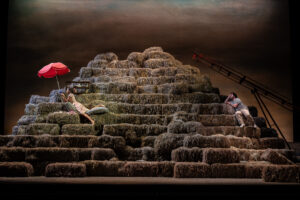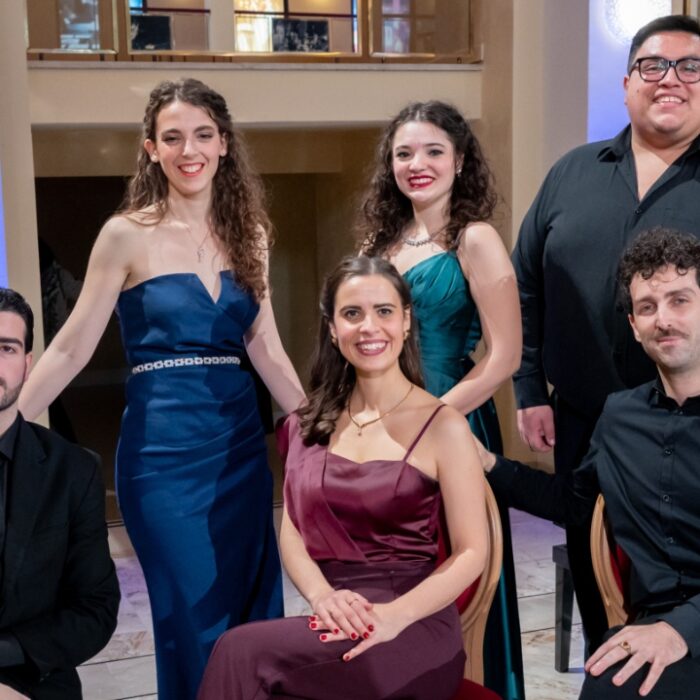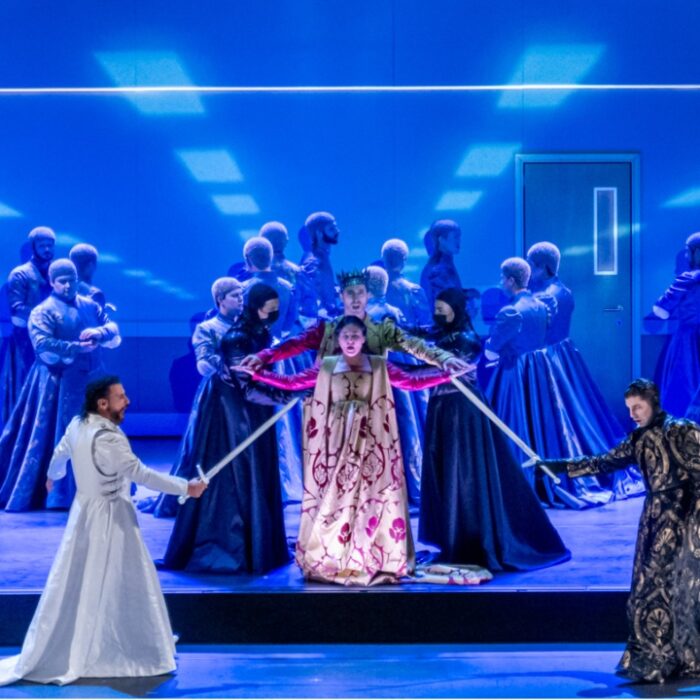
Royal Opera House 2023-24 Review: L’Elisir d’Amore
Laurent Pelly’s Operatic Ice Cream Float Parade Is Six Parts Froth and Two Parts Substance
By Sophia Lambton(Photo credit: Clive Barda/Royal Opera House)
Nestling zest into impressionable appetites, bel canto master Donizetti’s “L’elisir d’amore” is a succulent confectioner’s delight: a cavalcade of strawberry and rhubarb shades that never age out of their calorific bubble. High on hyperactive captures of unravelling roulades and supercilious trills, its teasing feast of overblown, meringue-like vows empowers risk-taking directors.
Decking his décor with over-the-top symbols, French auteur Laurent Pelly relies on paler imagery in this now seventeen-year-old production. As Nemorino rinses his moroseness in the mournful ode “Una furtiva lagrima,” a spray of garish lightbulbs sink into the two-dimensional cerulean backdrop. Basque terrain ingrains itself into the spectacle by virtue of a pyramid of haystacks: a giant rusty bust entrusted with portraying rustic life. Red beach umbrellas straight out of a 1980s Klondike cone commercial perch askew; conveying with the help of mint striped t-shirts and wan floral dresses a vanilla-colored parody of Spanish country life.
Visceral vignettes make up a portion of this microcosm nonetheless. A stage curtain awash in classifieds, displaying the miraculous effects of Dulcamara’s popular elixir, boasts of the insatiable potion being fit to cure both impotence, rheumatism, migraines and dry skin. The doctor’s truck—a Winnebago-like abode that houses garden chairs across a rooftop terrace lined with fairy lights—is pleasurably farcical. This invites humorous interactions from all around. A sidekick of the quack rolls up the vehicle’s sliding door—only to bump his head. Around him, minions synchronize to proffer the notorious antidote—whose real identity is red wine masked in a concealing flask. The flashiness of its fluorescent packaging suggests a drink about as curative as Dr. Pepper.
Tepid on the other hand is the envisioner’s embrace of the absurd. What manifests as one man’s milquetoast take on a Wes Anderson esthetic could have built a motlier array of operatic cornucopia: conceptualizing both more colorfully and grotesquely to create a tasty satire.
At risk of exiting its overbaked oven, thanks to innumerable revivals, this “L’elisir” fortunately hasn’t yet dried out its stars.
Star of the Night
Ebullient vibrato braced Nadine Sierra’s silvery soprano gave an uncanny rapture in her Royal Opera debut. Her fickle Adina’s indecisiveness poured out in sterling iterations resonating with the shimmers of cabasa beads. In the flighty heroine’s emphatic declarations—such as her refusal to accept Belcore’s proposal immediately, “Signorino, non ho fretta; un tantin pensar ci vo’”: “Mister, I’m in no rush – I would like some time to think.” The singer brandished spears of coruscating corpulence; an armor that at times exceeds Adina’s might.
Enlightening the lovesick Nemorino on her feelings’ unpredictability—“capricciosa io sono, e non v’ha brama; che in me tosto non muoia appena è desta” (“I’m capricious; there is no desire in me that does not expire when I wake”)—she appeared almost too sensible; too much of the “straight man” in a buffoonish showcase rife in equal opportunity lampooning. The upper hand was dealt to her in rebuffing body language: Adina chided Nemorino with a little slap in one moment, followed by a purposely standoffish leg-crossing in the next. Her satisfaction made it the spectator’s pleasure to behold this spurner’s weaponry. And yet in love all parties lose—and Sierra’s imperturbable aplomb made her surrender less detectable than her eventual mate’s.
Coloratura comfortably coursed through Nadine Sierra’s voice most of the time, but risked being shredded into splitting streams at others. In the duet “Una parola, o Adina,” the roulade enveloping the “ghie” of “lushinghiera” in “Chiedi all’aura lusinghiera” (“Ask the flattering breeze”) lapsed into semi-muffled thirty-second notes. Also, an occasional crescendi burst out too abruptly. Majesty may have injected itself too much into an interpretation that could use more silliness. Yet, certain crowns of top notes—such as on the “sir” of the last “è l’elisir” in Act two—glistered irresistibly.
Matching Sierra in theatricality was tenor Liparit Avetisyan, who exercised tremendous effort to embody Pelly’s slapstick caliber of showpiece. Vocally, Avetisyan’s strengths fell short of full-fledged execution. He inflated introductory lines with a sometimes crass crescendo. Avetisyan exceeded the regality of “Quanto è bella, quanto è cara” (“How beautiful, how darling is she”) in his entrance; steeping into near-falsetto as he pleaded with Adina, “credimi, te ne scongiuro… Non puoi sposarlo te ne assicuro…” (“Adina, believe me, I beg you… you can’t marry [Belcore], I’m sure of it…). Oscillating between mezzo forte and fortissimo in “Una furtiva lagrima,” the tenor swallowed select syllables and slid less smoothly across “quelle festose giovani” (“those laughing youths”).
Speckles of mistakes derailed a rendering where recitative portions remained salient. Nemorino’s plaintive enquiry of Dulcamara, “Aveste voi per caso la bevanda amorosa della regina Isotta?” (“Do you by any chance have the love potion that Queen Isolde took?”) came off endearingly abashed. When finally he clasped the lifesaving elixir in his hands—“Caro elisir, sei mio!” (“Dear elixir, you are mine!”), Avetisyan distributed his breath to prettily display his alter ego’s awe. The incarnation overall encompassed tender qualities but needed to be retouched in order to emerge finished.
Solid Support
Stumbling drunkenly into a long-honed role, Bryn Terfel let loose Dulcamara’s reins with enviable revelry. Cavernous adventures of his bass notes crafted the quack doctor’s pretend clout with a stout vibrato; gouging bystanders convincingly. His comic choices were sometimes overdone, as Terfel mercilessly parodied his personage; delivering a lisp to “Io son ricco, tu sei bella” (“I am rich, you’re beautiful”) when Dulcamara labored (somewhat) to impress Adina. Staccato sections leapt with laughable legerity and yet endangered certain notes’ intonement; shackling the performer’s timbre at his natural gifts’ expense.
Embellishing Belcore with deft chromatic scales, bass Boris Pinkhasovich struck a balance between pompousness and technical precision. Sarah Dufresne ornamented her Giannetta with an apt naivety; extending slickness to a role responsible for leading the reactions of the chorus.
Elsewhere ratios were not proportionately dealt. Inducting the Romantic orchestra into a realm of baroque-imitating rhythms, maestro Sesto Quatrini dispelled at times cartoonish tempi emulating roasts of Haydn’s “Surprise” Symphony. Messiness entrenched the tone of strings and divided them until the section sounded disparate. In a distinctly questionable pairing, flutes sang over-perkily while cymbals softly banged. Crooning lower woodwind slipped conspicuously out of sync, but the pervasive harpsichord continuo was spared intrusion.
A composite of arbitrary elements, Pelly’s production is a heavily diluted paradigm of the assortment it could be: syrupy froth in place of opulent parfaits. This overused “L’elisir’s tonic only partially stumps the appetite—augmenting it instead with its bland aftertaste.



